Agricultural extension agents are getting seed of quality protein maize to the mountainous areas in the Philippines and encouraging smallholder farmers in its use. Widespread use of this nutritionally-enhanced maize can potentially help reduce rice dependency, improve child nutrition, and supply grain for inner city school meal programs.
Maize is not the first crop that comes to mind when one thinks about the Philippines, where rice paddies dominate the landscape. But a traveler to the nation’s mountainous regions will increasingly find maize crops there. Through public sector maize breeders and extension officers, upland farmers are beginning to sow the seed of an improved quality protein maize (QPM) variety. QPM looks, grows, and tastes like normal maize but contains higher levels of two essential amino acids, lysine and tryptophan, for protein synthesis in humans and farm animals like pigs and poultry. Nutritional studies in Ethiopia have already demonstrated that QPM consumption can reduce or prevent stunted growth in young children whose diets are heavy in maize.
Where small is not always good, quality counts
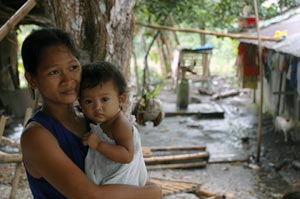 The Philippine uplands are home to the poorest farmers and minority groups, for whom arable land is scarce and hunger a constant threat. The average family includes at least five children, and must survive on a farm homestead of only one hectare. Antonio Rodriguez is a 46-year-old farmer in Jose V. Dayao village outside of Naga City. He struggles to put food on the table for a family that includes
The Philippine uplands are home to the poorest farmers and minority groups, for whom arable land is scarce and hunger a constant threat. The average family includes at least five children, and must survive on a farm homestead of only one hectare. Antonio Rodriguez is a 46-year-old farmer in Jose V. Dayao village outside of Naga City. He struggles to put food on the table for a family that includes
six children. “We own half a hectare of land and rent an additional two hectares,” he explains, “but it is not enough to support our family.” In a nearby village, farmer Geraldine Delphino and her husband must feed themselves and their five children from little more than half a hectare of land. “My husband and I are both farmers,” says Delphino. “He often works as a laborer on other farms. We sell whenever we have a surplus and buy white maize when we can.”
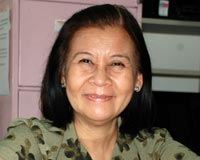 Wilma Hurtada, Food Science Professor at the University of the Philippines, Los Baños, has studied QPM and nutrition in children. “For families with limited land, limited resources, and a large family, the quality of the food they grow is very important,” she says.
Wilma Hurtada, Food Science Professor at the University of the Philippines, Los Baños, has studied QPM and nutrition in children. “For families with limited land, limited resources, and a large family, the quality of the food they grow is very important,” she says.
Reaching farmers in the marginal areas
As in many developing countries, in the Philippines yellow-grained maize is grown mostly by large-scale commercial farmers for animal feed and non-food uses. White-grained maize is produced by smallholders and used for human foods, particularly in maize-dependent upland areas, according to Art Salazar, Principal Maize Breeder at the Institute for Plant Breeding (IPB), Los Baños. “It’s difficult to reach farmers with improved white maize cultivars,” says Salazar. “They live in the marginal areas, on the outskirts of economic activity.”
The IPB took QPM seed from CIMMYT, where this specialty maize was developed, and over four years adapted it to local conditions. A QPM variety was finally released by the National Seed Industry Council in 2008. “Now we have a variety which is high in lysine and tryptophan and which suits the climate of the Philippines and Filipino taste preferences,” says Salazar. “This was all done through conventional breeding and research collaboration with CIMMYT.”
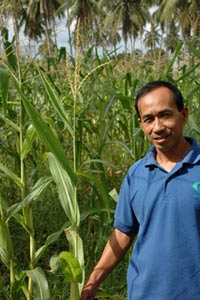 To test and promote the white QPM with farmers and distribute seed, Salazar relies on the extension support of experts from diverse Philippine institutions. One is Efren E. Magulama, a maize breeder at the University of Southern Mindanao. “We work with about 20 farmers in Region XII Province of North Cotabato, Magpet Municipality, to introduce QPM into communities—mostly in the mountainous regions, which are difficult to reach,” says Magulama.
To test and promote the white QPM with farmers and distribute seed, Salazar relies on the extension support of experts from diverse Philippine institutions. One is Efren E. Magulama, a maize breeder at the University of Southern Mindanao. “We work with about 20 farmers in Region XII Province of North Cotabato, Magpet Municipality, to introduce QPM into communities—mostly in the mountainous regions, which are difficult to reach,” says Magulama.
Farmer Marevic Fraile in Magpet Municipality, North Cotabato grows rubber, banana, coffee, and cocoa to sell, but grows maize for food. “We eat maize three times a day with every meal, mostly as grits,” Fraile explains. “We used to grow Tiniguib [a white maize variety popular in the Philippines], but when we switched to QPMour yields improved.”
Studies have shown that on average the QPM developed by the Filipino breeders yields 10% more than traditional white maize varieties. This is particularly important for its adoption by maize-dependent farmers, who are interested first and foremost in higher yields.
Homing in on nutrition
The nutritional advantages of QPM create opportunities to foster demand at some novel points in the food value chain, raising its interest for the farmers and seed producers. Salazar is working with Filipino health officials (in the Department of Social Welfare and Development and the Department of Health) and partners like Hurtada to introduce QPM grits into school meal programs in the poorest districts of Metropolitan Manila. “The national average of stunting in children in the Philippines is 29%; also 30% are energy deficient,” says Hurtada. “That’s just the national profile. When you go to the areas we’re targeting, you see a much higher incidence.”
The project aims to work with families whose parents have daily incomes under USD 1.20. “The children receive only about 980 calories a day,” says Hurtada. “They go to school without breakfast. When we ask how often they eat, they tell us one or two times a day.” The goal of the feeding program is to reach 1 million children, starting with 150 schools in Quezon City. “If we can do that, then we can really make a big impact on reducing malnutrition among children and general food security in the Philippines.”
“Instead of food aid, this initiative is developing a market for white maize farmers, improving nutrition for both farmers and school children, and contributing to the growth of the Filipino economy,” explained Salazar.
For more information: Michelle Defreese (m.defreese@cgiar.org)
Art Salazar Interview

Dr. Artemio Salazar is the Principal Maize Breeder at the Institute of Plant Breeding (IPB) in Los Baños, Philippines. He has been working on maize for the past 30 years, developing lines adapted to conditions in the Philippines from the germplasm sourced from indigenous farmers, local partners, and international organizations such as CIMMYT. He is the Deputy Director of the University of the Philippines’ Crop Science cluster in Los Baños.
In a rice-dependent country like the Philippines, how did you decide to become involved with maize breeding?
I completed my BSc in Agricultural Chemistry but soon became fed up of being around chemicals, so I shifted to agronomy. I really enjoyed working outdoors, being in the fresh air. I was approached by the first director of IPB in 1975 to be a part of the first technical staff of the Institute. I completed my PhD at Iowa State University in 1985. Now I realize I made the right choice because maize can and will help address nutritional needs and food insecurity issues in the Philippines.
How do you see maize playing a role in food security in the Philippines?
The Philippines should not be importing rice. 10% of rice importations could easily be filled by maize. If you could convince the equivalent of Filipinos to eat maize or a rice/maize blend, we would not have to import rice. We could eventually become a net exporter of rice. Importing rice does not make a lot of sense when there are maize substitutes. It aggravates social problems. If maize famers are poor, they will flock to the cities or become rebels. That has tremendous social costs. Investing in maize is a way to stem patterns of rural to urban migration.
What role do you see QPM varieties having in the Philippines?
Maize has been here all along for the past five hundred years or so. QPM can be a rally point for people to become interested in maize because it has a more balanced protein quality. If you can stimulate an increased interest in maize through QPM, half the problem would be solved.
You’ve also been involved in developing mills to produce maize grits and maize flour. What role do you see these playing in improving food security?
Crops are grown in the rural areas and they have to be milled. So they bring them down do the lowland areas to process them and bring them back up to the mountainous areas. The mills have to be cheap, efficient, and mobile. These mills (cost) only USD 1,500 and can be used with gasoline instead of electricity. 25 billion pesos of wheat flour are imported every year; that’s USD 500 million. If you substituted 20% of that with corn flour, you could recover the cost of USD 100 million. If you transmitted that to rural farmers, imagine what kind of impact that would have. Plus, the maize still retains its QPM properties, even when milled.
What is the role CIMMYT is playing in this initiative?
One thing is for certain, this project is not relying on foreign funds or institutions. This is a Filipino initiative. The germplasm which CIMMYT has been providing is already a big help. Collaboration of this kind can really help host countries. Funds should be sourced from government resources because it is sustainable. Funds should also come from the private sector. Then, it continues on and on. That is sustainable funding.
Creating an impact does not have to be an expensive proposition. If you can develop a technology and the host country can make full use of it, you can have a tremendous impact. When we started this, there was no foreign funding – only local funds in addition to CIMMYT germplasm and collaboration. A little research collaboration like the interaction between CIMMYT and IPB can go a long way. |
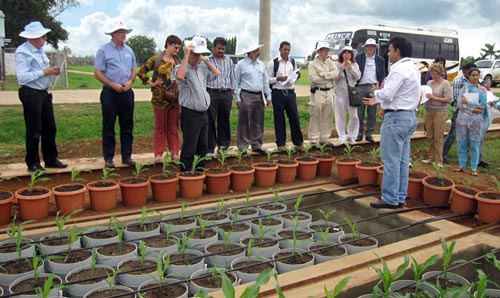 After a formal introduction, Zaidi gave an overview of the research program and priorities of the CIMMYT-Asia maize program, and the ongoing collaborations with various public and private institutions in the region, including the International Maize Improvement Consortium (IMIC-Asia). He emphasized CIMMYT’s initiatives towards purposeful partnerships, which offer a big opportunity for pro-poor agricultural investment and innovations (such as IMIC-Asia and MAIZE), the global alliance for food security, and the livelihood of resource-poor in the developing world.
After a formal introduction, Zaidi gave an overview of the research program and priorities of the CIMMYT-Asia maize program, and the ongoing collaborations with various public and private institutions in the region, including the International Maize Improvement Consortium (IMIC-Asia). He emphasized CIMMYT’s initiatives towards purposeful partnerships, which offer a big opportunity for pro-poor agricultural investment and innovations (such as IMIC-Asia and MAIZE), the global alliance for food security, and the livelihood of resource-poor in the developing world. The Philippine uplands are home to the poorest farmers and minority groups, for whom arable land is scarce and hunger a constant threat. The average family includes at least five children, and must survive on a farm homestead of only one hectare. Antonio Rodriguez is a 46-year-old farmer in Jose V. Dayao village outside of Naga City. He struggles to put food on the table for a family that includes
The Philippine uplands are home to the poorest farmers and minority groups, for whom arable land is scarce and hunger a constant threat. The average family includes at least five children, and must survive on a farm homestead of only one hectare. Antonio Rodriguez is a 46-year-old farmer in Jose V. Dayao village outside of Naga City. He struggles to put food on the table for a family that includes Wilma Hurtada, Food Science Professor at the University of the Philippines, Los Baños, has studied QPM and nutrition in children. “For families with limited land, limited resources, and a large family, the quality of the food they grow is very important,” she says.
Wilma Hurtada, Food Science Professor at the University of the Philippines, Los Baños, has studied QPM and nutrition in children. “For families with limited land, limited resources, and a large family, the quality of the food they grow is very important,” she says. To test and promote the white QPM with farmers and distribute seed, Salazar relies on the extension support of experts from diverse Philippine institutions. One is Efren E. Magulama, a maize breeder at the University of Southern Mindanao. “We work with about 20 farmers in Region XII Province of North Cotabato, Magpet Municipality, to introduce QPM into communities—mostly in the mountainous regions, which are difficult to reach,” says Magulama.
To test and promote the white QPM with farmers and distribute seed, Salazar relies on the extension support of experts from diverse Philippine institutions. One is Efren E. Magulama, a maize breeder at the University of Southern Mindanao. “We work with about 20 farmers in Region XII Province of North Cotabato, Magpet Municipality, to introduce QPM into communities—mostly in the mountainous regions, which are difficult to reach,” says Magulama.
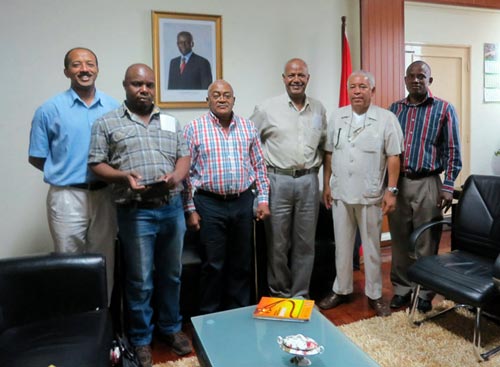 The CIMMYT team, accompanied by Nginamau and Faceira, had a second meeting with Prata Junior on 22 June 2012. Thanking him for the warm welcome and willingness to support DTMA work in Angola, Abate pointed out the need for favorable policies on variety release and the involvement of the private sector in developing a sustainable seed production and delivery system. Discussions during the meeting also emphasized the need for the agriculture ministry to set targets for increasing the maize yield within the next five years. Abate reiterated CIMMYT’s willingness to offer technical support towards achieving the government’s goal of accelerated maize production. Prata Junior welcomed the suggestions and asked for immediate support in capacity building. He also emphasized the need for the capacity to produce basic seed within Angola and pointed out that the country is importing an additional 20,000 tons seed for the coming season. Prata Junior said the introduction of early-maturing hybrids would be highly appreciated in light of recurrent droughts in the country. He also pledged to follow up with the MOARDF for the large-scale dissemination of DTMA varieties.
The CIMMYT team, accompanied by Nginamau and Faceira, had a second meeting with Prata Junior on 22 June 2012. Thanking him for the warm welcome and willingness to support DTMA work in Angola, Abate pointed out the need for favorable policies on variety release and the involvement of the private sector in developing a sustainable seed production and delivery system. Discussions during the meeting also emphasized the need for the agriculture ministry to set targets for increasing the maize yield within the next five years. Abate reiterated CIMMYT’s willingness to offer technical support towards achieving the government’s goal of accelerated maize production. Prata Junior welcomed the suggestions and asked for immediate support in capacity building. He also emphasized the need for the capacity to produce basic seed within Angola and pointed out that the country is importing an additional 20,000 tons seed for the coming season. Prata Junior said the introduction of early-maturing hybrids would be highly appreciated in light of recurrent droughts in the country. He also pledged to follow up with the MOARDF for the large-scale dissemination of DTMA varieties.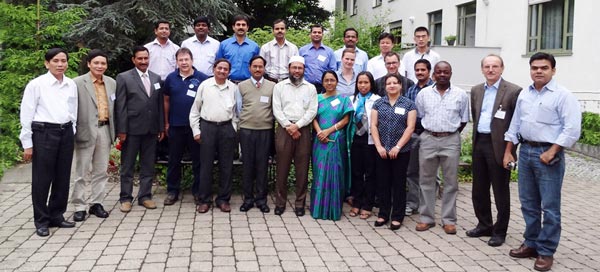
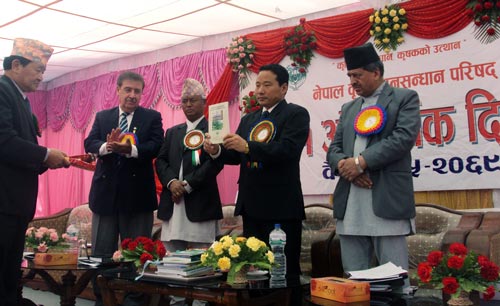 The gathering brought together more than 275 scientists and development workers. “The Nepal Government is planning to raise the budget for agriculture significantly in the upcoming national budget plan” said Pun. “There is also a need to adopt enhanced technology to double agricultural production and to attract youth to the sector,” he added. Pun also mentioned that “the Prime Minister and his Government are committed to giving top priority to farming as it is the only way to alleviate poverty and ensure employment for a larger section of society”.
The gathering brought together more than 275 scientists and development workers. “The Nepal Government is planning to raise the budget for agriculture significantly in the upcoming national budget plan” said Pun. “There is also a need to adopt enhanced technology to double agricultural production and to attract youth to the sector,” he added. Pun also mentioned that “the Prime Minister and his Government are committed to giving top priority to farming as it is the only way to alleviate poverty and ensure employment for a larger section of society”.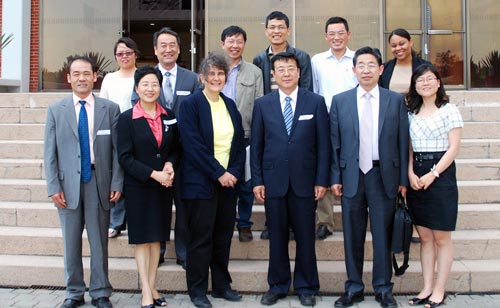 Whilst Director General Thomas Lumpkin is in China meeting with the ex- and current Presidents of the Chinese Academy of Agricultural Sciences (CAAS) in Beijing, a delegation of six CAAS representatives took the opportunity to come to El Batán to discuss collaborations between CIMMYT and China and opportunities for future projects. Li Jinxiang, Vice President, Ye Zhihua, Director General of the Institute of Quality Standard and Testing Technology for Agro-Products, Chen Wanquan, Director Generation of the Institute of Plant Protection, Li Sijing, Vice President of the Graduate School, Niu Liping, Deputy Director General of the Logistic Service Center, and Wang Jing, Project Officer of the Department of International Cooperation of CAAS visited CIMMYT while in Mexico for the G20 meetings.
Whilst Director General Thomas Lumpkin is in China meeting with the ex- and current Presidents of the Chinese Academy of Agricultural Sciences (CAAS) in Beijing, a delegation of six CAAS representatives took the opportunity to come to El Batán to discuss collaborations between CIMMYT and China and opportunities for future projects. Li Jinxiang, Vice President, Ye Zhihua, Director General of the Institute of Quality Standard and Testing Technology for Agro-Products, Chen Wanquan, Director Generation of the Institute of Plant Protection, Li Sijing, Vice President of the Graduate School, Niu Liping, Deputy Director General of the Logistic Service Center, and Wang Jing, Project Officer of the Department of International Cooperation of CAAS visited CIMMYT while in Mexico for the G20 meetings.
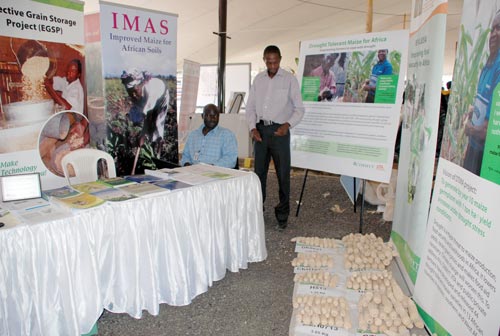 As part of European Union Day celebrations in Kenya, an exhibition to showcase research and development activities supported by the EU or its member states took place on 09 May 2012 at the International Centre of Insect Physiology and Ecology (ICIPE) in Nairobi. CIMMYT was among 12 exhibitors participating and featured the projects Drought Tolerant Maize for Africa (DTMA), Insect Resistant Maize for Africa (IRMA), Effective Grain Storage (EGS), Improved Maize for African Soils (IMAS), and Sustainable Intensification of Maize-Legume Cropping System for Food Security in Eastern and Southern Africa (SIMLESA). On display were cobs of CIMMYT and commercial maize hybrids harvested from drought stressed plots alongside cobs of the same hybrids from fully irrigated plots. Several CIMMYT publications were available for visitors.
As part of European Union Day celebrations in Kenya, an exhibition to showcase research and development activities supported by the EU or its member states took place on 09 May 2012 at the International Centre of Insect Physiology and Ecology (ICIPE) in Nairobi. CIMMYT was among 12 exhibitors participating and featured the projects Drought Tolerant Maize for Africa (DTMA), Insect Resistant Maize for Africa (IRMA), Effective Grain Storage (EGS), Improved Maize for African Soils (IMAS), and Sustainable Intensification of Maize-Legume Cropping System for Food Security in Eastern and Southern Africa (SIMLESA). On display were cobs of CIMMYT and commercial maize hybrids harvested from drought stressed plots alongside cobs of the same hybrids from fully irrigated plots. Several CIMMYT publications were available for visitors.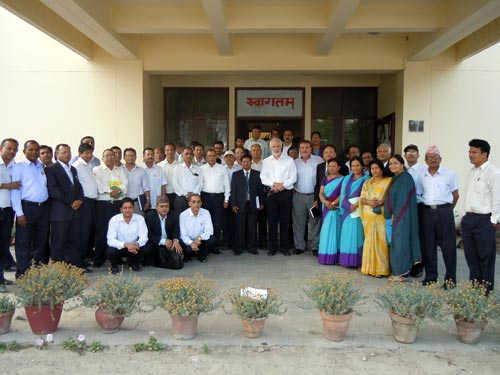 CIMMYT director general Thomas Lumpkin visited Nepal during 01-03 May 2012. One of the main objectives of his visit was to discuss the Borlaug Institute for South Asia (BISA) launched last year in India, and the potential for Nepal to follow a similar model, with Nepal Agricultural Research Council (NARC) and CIMMYT scientists.
CIMMYT director general Thomas Lumpkin visited Nepal during 01-03 May 2012. One of the main objectives of his visit was to discuss the Borlaug Institute for South Asia (BISA) launched last year in India, and the potential for Nepal to follow a similar model, with Nepal Agricultural Research Council (NARC) and CIMMYT scientists. Food security is highlighted as one of the main priorities for Bangladesh in the country’s Investment Plan, and a sustainable seed supply constitutes a pivotal component of food security. With this in mind, a maize and wheat “seed summit” was jointly organized by the Ministry of Agriculture (MoA) and CIMMYT at the Hotel Lake Castle in Dhaka on 26 April 2012.
Food security is highlighted as one of the main priorities for Bangladesh in the country’s Investment Plan, and a sustainable seed supply constitutes a pivotal component of food security. With this in mind, a maize and wheat “seed summit” was jointly organized by the Ministry of Agriculture (MoA) and CIMMYT at the Hotel Lake Castle in Dhaka on 26 April 2012.